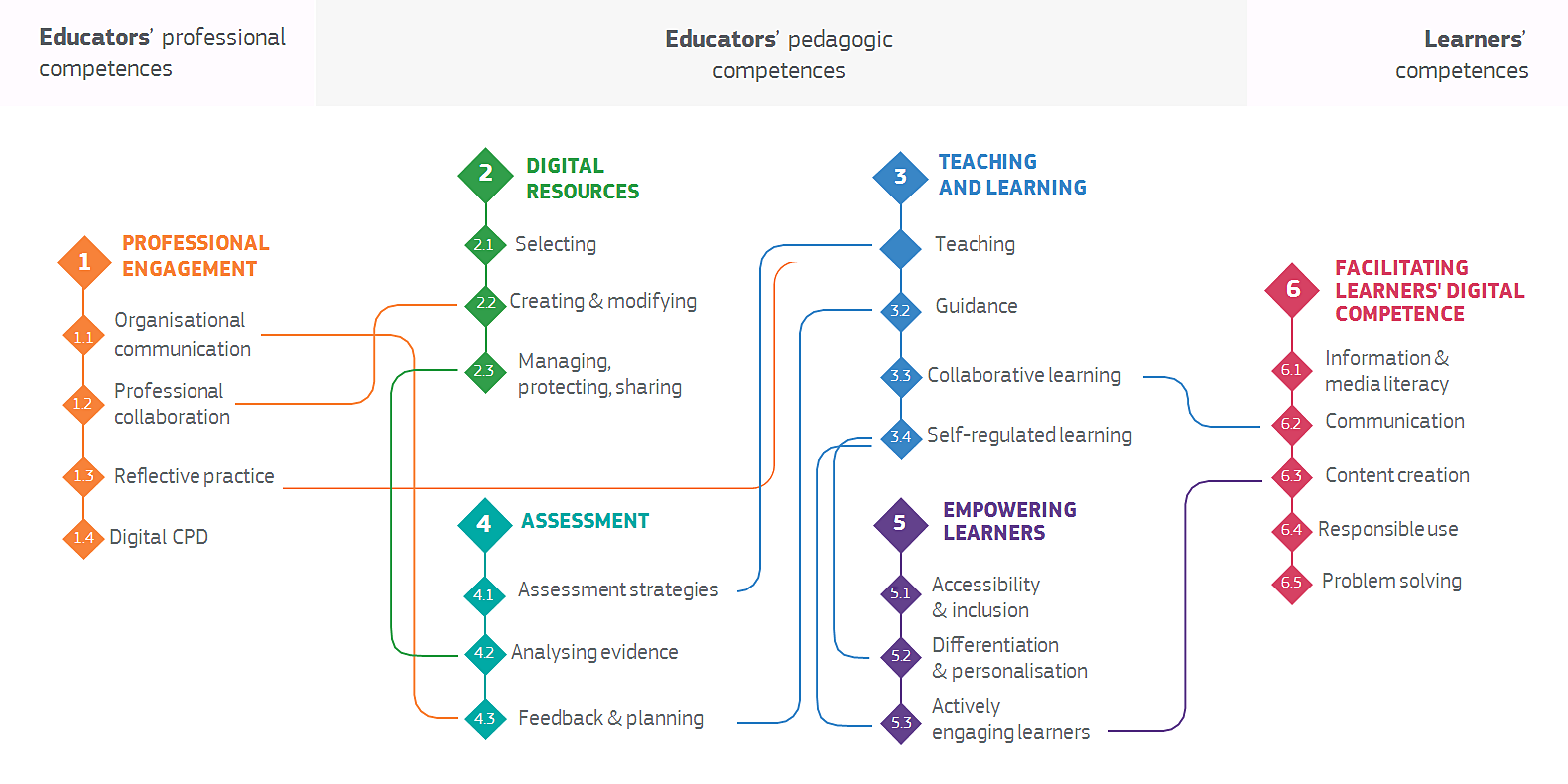DigCompEdu describes 22 competences organised in six Areas.

Area 1: Professional Engagement
1.1 Organisational communication
To use digital technologies to enhance organisational communication with learners, parents and third parties. To contribute to collaboratively developing and improving organisational communication strategies.
1.2 Professional Collaboration
To use digital technologies to engage in collaboration with other educators, sharing and exchanging knowledge and experience, and collaboratively innovating pedagogic practices.
1.3 Reflective Practice
To individually and collectively reflect on, critically assess and actively develop one's own digital pedagogical practice and that of one's educational community.
1.4 Digital Continuous Professional Development
To use digital sources and resources for continuous professional development.
Area 2: Digital Resources
2.1 Selecting digital resources
To identify, assess and select digital resources for teaching and learning. To consider the specific learning objective, context, pedagogical approach, and learner group, when selecting digital resources and planning their use.
2.2 Creating and modifying digital content
To modify and build on existing openly-licensed resources and other resources where this is permitted. To create or co-create new digital educational resources. To consider the specific learning objective, context, pedagogical approach, and learner group, when designing digital resources and planning their use.
2.3 Managing, protecting and sharing digital resources
To organise digital content and make it available to learners, parents and other educators. To effectively protect sensitive digital content. To respect and correctly apply privacy and copyright rules. To understand the use and creation of open licenses and open educational resources, including their proper attribution.
Area 3: Teaching and Learning
3.1 Teaching
To plan for and implement digital devices and resources in the teaching process, so as to enhance the effectiveness of teaching interventions. To appropriately manage and orchestrate digital teaching interventions. To experiment with and develop new formats and pedagogical methods for instruction.
3.2 Guidance
To use digital technologies and services to enhance the interaction with learners, individually and collectively, within and outside the learning session. To use digital technologies to offer timely and targeted guidance and assistance. To experiment with and develop new forms and formats for offering guidance and support.
3.3 Collaborative learning
To use digital technologies to foster and enhance learner collaboration. To enable learners to use digital technologies as part of collaborative assignments, as a means of enhancing communication, collaboration and collaborative knowledge creation
3.4 Self-regulated learning
To use digital technologies to support learners' self-regulated learning, i.e. to enable learners to plan, monitor and reflect on their own learning, provide evidence of progress, share insights and come up with creative solutions
Area 4: Assessment
4.1 Assessment strategies
To use digital technologies for formative and summative assessment. To enhance the diversity and suitability of assessment formats and approaches.
4.2 Analysing evidence
To generate, select, critically analyse and interpret digital evidence on learner activity, performance and progress, in order to inform teaching and learning.
4.3 Feedback and Planning
To use digital technologies to provide targeted and timely feedback to learners. To adapt teaching strategies and to provide targeted support, based on the evidence generated by the digital technologies used. To enable learners and parents to understand the evidence provided by digital technologies and use it for decision-making.
Area 5: Empowering Learners
5.1 Accessibility and inclusion
To ensure accessibility to learning resources and activities, for all learners, including those with special needs. To consider and respond to learners' (digital) expectations, abilities, uses and misconceptions, as well as contextual, physical or cognitive constraints to their use of digital technologies.
5.2 Differentiation and personalisation
To use digital technologies to address learners' diverse learning needs, by allowing learners to advance at different levels and speeds, and to follow individual learning pathways and objectives.
5.3 Actively engaging learners
To use digital technologies to foster learners' active and creative engagement with a subject matter. To use digital technologies within pedagogic strategies that foster learners' transversal skills, deep thinking and creative expression. To open up learning to new, real-world contexts, which involve learners themselves in hands-on activities, scientific investigation or complex problem solving, or in other ways increase learners' active involvement in complex subject matters.
Area 6: Facilitating Learners' Digital Competence
6.1 Information and media literacy
To incorporate learning activities, assignments and assessments which require learners to articulate information needs; to find information and resources in digital environments; to organise, process, analyse and interpret information; and to compare and critically evaluate the credibility and reliability of information and its sources.
6.2 Digital communication and collaboration
To incorporate learning activities, assignments and assessments which require learners to effectively and responsibly use digital technologies for communication, collaboration and civic participation.
6.3 Digital content creation
To incorporate learning activities, assignments and assessments which require learners to express themselves through digital means, and to modify and create digital content in different formats. To teach learners how copyright and licenses apply to digital content, how to reference sources and attribute licenses.
6.4 Responsible use
To take measures to ensure learners' physical, psychological and social wellbeing while using digital technologies. To empower learners to manage risks and use digital technologies safely and responsibly.
6.5 Digital problem solving
To incorporate learning activities, assignments and assessments which require learners to identify and solve technical problems, or to transfer technological knowledge creatively to new situations.
